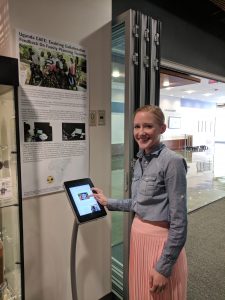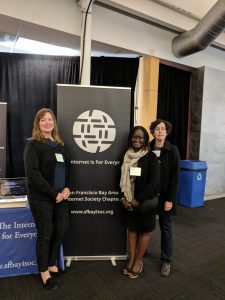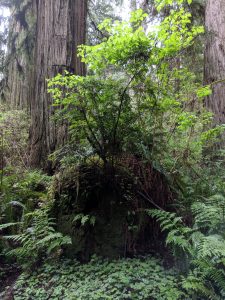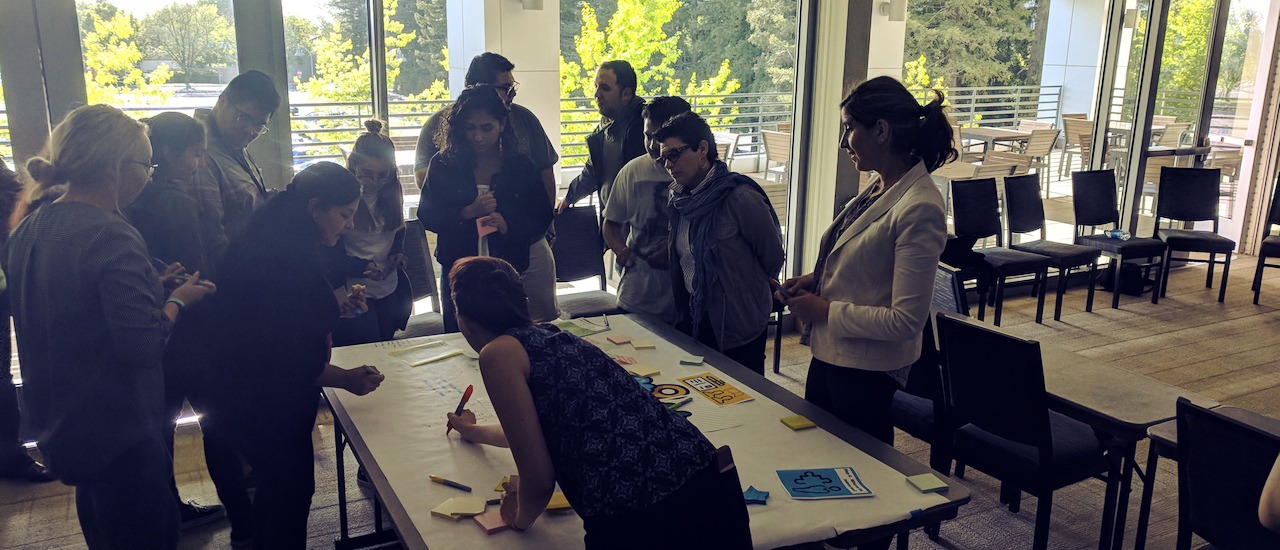Dustin Phillips, Co-Executive Director of ICANNWiki, is traveling across the United States in his red Toyota Corolla, making connections with the people who are making their communities – and the Internet – a better place. He visited the Bay Area, first making a stop at the Redwood National and State Parks, where he learned about redwood communities and how their survival is dependent on interconnection, a metaphor for the Internet itself.
What is the Internet Ecosystem?
The Internet affects nearly every aspect of society, creating an extremely wide range of stakeholders. There is still a community of stakeholders engaged directly with the Internet’s policymaking processes, but increasingly there are Internet-related discussions occurring at what would traditionally be considered unlikely venues.
CITRIS and the Banatao Institute
 Meeting with Dr. Brandie Nonnecke at the University of California, Berkley’s Center for Information Technology Research in the Interest of Society (CITRIS) and the Banatao Institute was a fitting way to kick off my time in the Bay Area. We had a great discussion on the important role of civic participation and collaborative processes for informed decision-making in key issue areas.
Meeting with Dr. Brandie Nonnecke at the University of California, Berkley’s Center for Information Technology Research in the Interest of Society (CITRIS) and the Banatao Institute was a fitting way to kick off my time in the Bay Area. We had a great discussion on the important role of civic participation and collaborative processes for informed decision-making in key issue areas.
Like the incredibly diverse plant life that grows in the understory of the Redwood forests, the Internet and its associated technologies can provide a framework for decsion-making that leads to a balanced and thriving ecosystem.
Her research on the Internet Governance Forum (IGF) surveyed participants on their knowledge of Internet governance (IG) Issues, trust in institutions, and perceived self-efficacy before and after participating. The results of the survey suggest that direct participation positively impacts participant’s trust in the system and belief in their ability to contribute meaningfully.
Her work is also applicable beyond the Internet Governance context. Through her work on the Collaborative Assessment and Feedback Engine (CAFE), an open-source, e-participation platform, she has demonstrated the applicability of creative technology for reaching better societal outcomes. CAFE crowdsources feedback on key social issues, including family planning, disaster preparedness, and government performance. It applies statistical modeling and collaborative filtering to this feedback to quickly identify emerging trends and key insights.
Our discussion highlighted the feeling of empowerment that comes from actively providing input into decision-making processes and the value of tools that make this possible. This has been demonstrated over and over across a wide variety of societal issues, including the development of the Internet. However, we need to continue to look at the Internet as a tool to empower all stakeholders to take an active role in contributing to a more stable and balanced ecosystem.
IGF-USA On the Road: Bay Area
The Internet ecosystem contains many different elements with unique perspectives and areas of focus. On May 2, the San Franscisco-Bay Area Internet Society Chapter organized and cloudflare hosted the inaugural IGF-USA On the Road event to bring together those interested in Content Moderation and Intermediary Liability. This marked a positive step for the IGF-USA community in increasing the inputs from communities across the USA.
The discussion brought together a fantastic panel different perspectives, including:
- Mitch Stolz, Senior Staff Attorney, Electronic Frontier Foundation
- Jacob Rogers, Legal Counsel, Wikimedia Foundation
- Evan Engstrom, Executive Director, Engine
- Daphne Keller (Moderator), Director, Intermediary Liability, Center for Internet and Society, Stanford Law School
It also demonstrates one of the key tenets of the Internet Society’s Collaborative Governance Project, which is gathering around timely issues and actionable outcomes. When there is an imbalance in the ecosystem, it is the community’s job to correct that. However, different issues require different actors to discuss different solutions. Gathering the input and engagement from stakeholders at the right time on the right issue is increasingly important.
Knowing which stakeholders to gather around a particular issue is a key element of reaching the best outcomes. This is increasingly complex in a world where nearly every aspect of society is touched by the Internet.
Silicon Valley AgTech Conference
 I attended the Silicon Valley AgTech Conference to support the showcase of the San Franscisco-Bay Area Internet Society Chapter‘s Bridging California’s Rural/Urban Digital Divide with Mobile Broadband project, in which they teamed up with California State University (CSU) Geographical Information Center (GIC), Chico, and Valley Vision to collect data on mobile broadband performance in Yolo County, California to demonstrate the lack of reliable connectivity for farmers in the region.
I attended the Silicon Valley AgTech Conference to support the showcase of the San Franscisco-Bay Area Internet Society Chapter‘s Bridging California’s Rural/Urban Digital Divide with Mobile Broadband project, in which they teamed up with California State University (CSU) Geographical Information Center (GIC), Chico, and Valley Vision to collect data on mobile broadband performance in Yolo County, California to demonstrate the lack of reliable connectivity for farmers in the region.
While at the conference, I was surprised by the number of topics discussed I would expect to find at an Internet Governance meeting. In talking with attendees about the issues their communities care about, we were able to find some overlap with nearly all of the issue areas that will be discussed at the IGF-USA 2018, including access, Internet of Things, and data governance. Despite these shared interests, the AgTech community rarely engages in the Internet policy discussions. This is not surprising, considering that the agricultural industry is busy focusing on optimizing their operations. Their perspective on the Internet and connected technologies should be recognized. Efficient production and food security are issues with far reaching global implications. We need to understand the role the Internet plays in various communities and use that input to reach better decisions for all.
Innovative Resilience
On my last night in the Bay Area, I attended a joint workshop put together by 10,000 Degrees and International Connector at Sonoma State University. 10,000 degrees is a non-profit organization that helps students from low-income backgrounds get to and through college. International Connector is an organization that works to empower young innovators to have a great social impact.
The workshop gathered students from the North Bay Area who are part of the 10,000 program and discussed 6 questions.
- What do you like about your community?
- What needs does your community have?
- What do you want to do?
- What are your skills?
- What are you barriers?
- What steps can you take to utilize your skills and overcome the barriers?
The Internet was not a focal point of the dicussion, but there were issues and themes that are applicable to the Internet and the multistakeholder process. In this case, the students expressed a need for guidance, information, and resources. Similarly, there were community members present who either directly or indirectly had the ability to help with these needs. However, up until they gathered in that room, they were not aware of each other. Whether we are talking about Internet Governance, or other collaborative processes, connecting the right stakeholders is essential.
Networks of People
The  reason why there are so many passionate actors fighting to make the Internet better is not simply a love for the technical networks, but rather the networks of people who can use the Internet to make their communities better. However, listening to the students at Sonoma State University highlighted a theme that I have observed in nearly every community I have visited or engaged with. Despite the incredible power of the Internet to connect, there are still gaps in our networks of people. Essentially, those who should be connecting with each other aren’t.
reason why there are so many passionate actors fighting to make the Internet better is not simply a love for the technical networks, but rather the networks of people who can use the Internet to make their communities better. However, listening to the students at Sonoma State University highlighted a theme that I have observed in nearly every community I have visited or engaged with. Despite the incredible power of the Internet to connect, there are still gaps in our networks of people. Essentially, those who should be connecting with each other aren’t.
In the Redwood forest, there is a network of giant trees that establishes an environment in which various plants can thrive, including various bushes that produce berries. These berries provide for birds, bears and other wildlife. These animals help spread the seed of the plants, which aids growth of new plants and produces more food. This just barely scratches the surface of the complexities of this ecosystem, but it demonstrates an important point. If the berries disappeared, the forest would no longer be inhabitable for the animals, which would lead to an imbalance in the system. These forests have had the benefit of thousands of years to reach equilibrium and have demonstrated a tremendous amount of stability and resiliency in the process.
The communities discussing the future of the Internet need to to engage the increasingly wide range of stakeholders and focus the discussion on empowering people to use the Internet to make their communities and the world a better place. We can learn from the forests of Northern California and focus on extending our reach wider, not deeper and creating a hospitable environment for everyone in our ecosystem to thrive.
For an Internet to exist for the good of all people, it must be shaped by diversity, inclusion, and equality. Learn about Internet Governance and why every voice matters.

